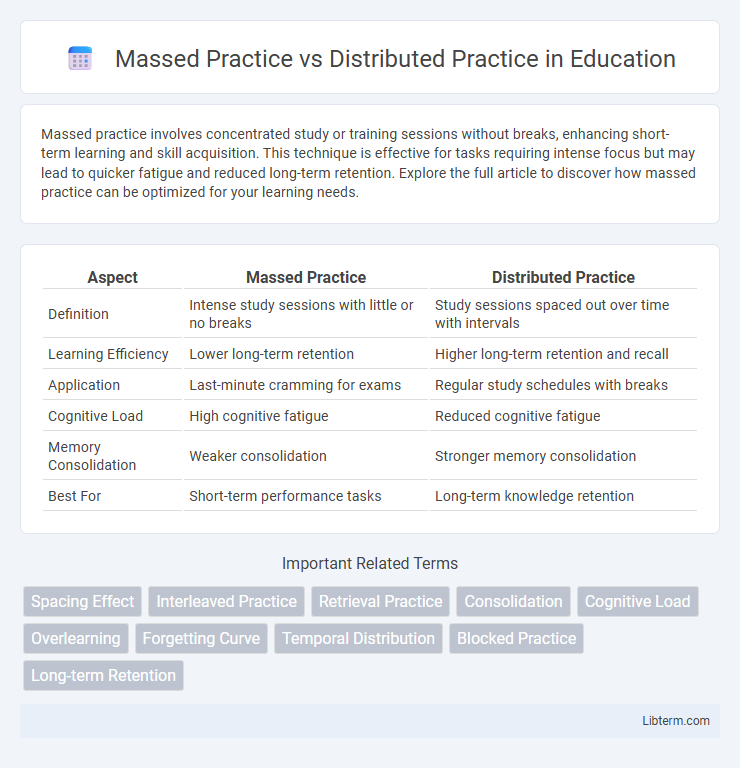Massed practice involves concentrated study or training sessions without breaks, enhancing short-term learning and skill acquisition. This technique is effective for tasks requiring intense focus but may lead to quicker fatigue and reduced long-term retention. Explore the full article to discover how massed practice can be optimized for your learning needs.
Table of Comparison
| Aspect | Massed Practice | Distributed Practice |
|---|---|---|
| Definition | Intense study sessions with little or no breaks | Study sessions spaced out over time with intervals |
| Learning Efficiency | Lower long-term retention | Higher long-term retention and recall |
| Application | Last-minute cramming for exams | Regular study schedules with breaks |
| Cognitive Load | High cognitive fatigue | Reduced cognitive fatigue |
| Memory Consolidation | Weaker consolidation | Stronger memory consolidation |
| Best For | Short-term performance tasks | Long-term knowledge retention |
Understanding Massed Practice
Massed practice involves concentrating study or training sessions into a short, intensive period, often leading to rapid gains in skill or knowledge. This technique can improve short-term performance but tends to result in lower long-term retention compared to spaced repetition. Research highlights that massed practice may cause cognitive fatigue, reducing overall learning efficiency over extended periods.
Defining Distributed Practice
Distributed practice refers to a learning strategy where study sessions are spaced out over time rather than concentrated in a single period. Research in cognitive psychology demonstrates that distributed practice enhances long-term retention and facilitates deeper encoding of information. Compared to massed practice, this method reduces cognitive fatigue and leverages the spacing effect to improve memory consolidation.
Key Differences Between Massed and Distributed Practice
Massed practice involves intense, focused study sessions with little to no breaks, leading to quick skill acquisition but often increased fatigue and lower long-term retention. Distributed practice spaces learning over time, promoting better memory consolidation and higher retention rates by allowing rest periods between sessions. Research consistently shows distributed practice results in more durable learning outcomes compared to massed practice's short-term gains.
Cognitive Foundations of Practice Schedules
Massed practice involves continuous repetition without rest, often leading to cognitive overload and reduced long-term retention. Distributed practice spaces learning sessions over time, enhancing memory consolidation and retrieval through the spacing effect. Cognitive theories support distributed schedules as more effective for durable learning by allowing neural processes to strengthen memory traces between sessions.
Research Findings: Which Method is More Effective?
Research consistently shows distributed practice enhances long-term retention and transfer of knowledge compared to massed practice, which often leads to quick forgetting despite initial performance boosts. Studies in cognitive psychology indicate spaced repetition optimizes memory consolidation by allowing neural processes to stabilize over time. Meta-analyses confirm distributed practice significantly improves learning efficiency across diverse subjects and skill levels.
Benefits of Massed Practice
Massed practice enhances skill acquisition through intense, focused repetition, leading to rapid initial improvement in tasks requiring physical or cognitive performance. This concentrated approach benefits short-term retention and helps learners build muscle memory quickly, especially in activities like sports or language drills. Massed practice is effective for mastering specific tasks under time constraints, facilitating immediate performance gains.
Advantages of Distributed Practice
Distributed practice enhances long-term retention by spacing learning sessions over time, which strengthens memory consolidation and reduces cognitive fatigue. This method promotes deeper understanding and improved skill acquisition compared to massed practice, where cramming leads to quicker forgetting and burnout. Empirical studies show learners who use distributed practice outperform those relying on massed sessions in both recall accuracy and application efficiency.
Choosing the Right Practice Approach
Choosing the right practice approach depends on learning goals and retention needs; massed practice involves intense, concentrated study sessions that can boost short-term performance but often lead to quicker forgetting. Distributed practice, which spaces learning over time, enhances long-term retention by allowing cognitive consolidation and reducing mental fatigue. Research from cognitive psychology consistently supports distributed practice for durable memory and skill acquisition across various disciplines.
Applications in Education and Skill Training
Massed practice, involving continuous repetition over a short period, is effective for learning specific, discrete skills such as vocabulary memorization but often leads to rapid fatigue and diminished retention. Distributed practice, spacing learning sessions over time, enhances long-term retention and transfer of complex skills by allowing cognitive consolidation and reducing interference. In educational settings and skill training, incorporating distributed practice improves mastery of concepts and procedural knowledge, making it a preferred strategy for sustained skill development and academic achievement.
Tips for Implementing Effective Practice Schedules
Implement effective practice schedules by prioritizing distributed practice, which spaces learning sessions over time to enhance long-term retention and reduce cognitive fatigue. Incorporate consistent, shorter practice intervals with regular breaks to maximize focus and prevent burnout, leveraging the spacing effect established in cognitive psychology. Use tools like spaced repetition software or timed calendars to systematically plan practice sessions, ensuring content is reviewed just as it begins to fade from memory.
Massed Practice Infographic

 libterm.com
libterm.com